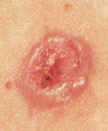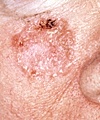Skin Cancer Information
from Aloha Dermatology and Laser Center
If you are having a problem with you skin on Maui
please make an appointment to see Dr Ly personally now!
Call 877-6526 or CLICK HERE --don't wait!
Being a dermatologist, I see a lot of unwanted lumps and bumps.
A changing mole or a lump or a bump can give you a great deal of stress, but with a simple process like a biopsy, to send to the pathologist, we can find out what it is and advise the best treatment plan for you.
Skin cancer occurs when tissue grows at an uncontrollable and unpredictable rate forming an abnormal growth. A diagnosis of skin cancer can be a cause for real concern. If left untreated, the disease will continue to progress and can cause considerable damage, disfigurement, or even death. However, skin cancer is usually not life threatening and therapy does not have to be disfiguring. If detected early, skin cancer can be treated successfully. The most common types of skin cancer include basal cell carcinoma, squamous cell carcinoma, and malignant melanoma.

2. Squamous Cell Carcinoma (SCC)


- According to the Centers for Disease Control, skin cancer is the most common and rapidly increasing form of cancer in the United States.
- Half of all new cancers are skin cancers.
- One in four Americans will develop skin cancer in his or her lifetime.
- Approximately 1.2 million new cases of skin cancer are diagnosed in the U.S. each year.
- The lifetime risk of developing malignant melanoma is estimated to be 1 in 50 and has risen sharply since the late 1930's when it was 1 in 1500.
What are the signs of skin cancer?
- Any growth or mark that has changed, grown or looks suspicious may indicate the presence of skin cancer. The following signs should be promptly investigated:
- A new growth on the skin that does not disappear in four to six weeks
- Any skin lesion that grows larger and turns red, brown, black or is multicolored
- A mole, birthmark or beauty mark that increases in size, changes color or texture or becomes irregular in outline
- An open sore or wound that refuses to heal, persists for more than four weeks or heals and later reopens
- Any skin spot or growth that continues to itch, hurt, crust over, forms a scab or sore, or bleeds for several weeks
Many skin growths may resemble skin cancer, but not all are malignant. Any suspicious-looking growth should be discussed with a Dermatologist.
Other causes include repeated medical and industrial X-ray exposure, scarring from severe burns and occupational exposure to certain chemical compounds.
It is important to note that treatments relying on the human eye to determine safety margin may prove ineffective. Removal of skin cancer is often complex because a tumor visible to the naked eye is usually the “tip of the iceberg”. It may have roots that are invisible, extending beyond the boundaries of the visible center. If these cancer cells are not completely removed they can lead to a recurrence of the tumor. When too little tissue is removed the cancer is not fully excised; when too much tissue is removed healthy tissue is lost. Because the Mohs procedure is microscopically controlled, it removes all the cancer and preserves as much healthy tissue as possible.
The treatment of each skin cancer must be individualized, taking into consideration such factors as the patient’s age, location of the cancer, type of cancer, and whether or not the cancer has been previously treated. In some instances, more than one type of skin cancer therapy may be appropriate. Your physician will discuss treatment alternatives with you to help decide what is the best treatment in your individual case.
How can I prevent skin cancer?
For more information contact the American Academy of Dermatology www.aad.org
Revanesse® Versa™+
We believe that everyone is naturally beautiful, which is why we specialize in helping our clients enhance their natural features with Revanesse® dermal fillers. We take special care to provide subtle and natural-looking results using Revanesse® fillers so you can enhance your features without changing who you are. Book book a consultation today with Dr...Continue reading→
Advise from Maui Dermatologist Dr. Micki Ly M.D – in Her Own Words – “Mole removal can be a simple process”
Do You have a mole that is very obvious and unwanted? We can take care of that for you - it's called the mole removal. The process is very simple. To view more information on Mole Removal and the reasons that you should have Dr. Ly evaluate them, if you have any, please visit the...Continue reading→
Eyelid surgery (blepharoplasty), for a more youthful appearance, from the series “Advise from Maui Dermatologist Dr. Micki Ly M.D – in Her Own Words”
If you're having a little difficulty putting on eye shadow or your eyeliners run, you might be just needing an eye surgery. A simple procedure that will make you look younger and put the twinkle back in your eyes. To view more information on Upper Eye Lid Surgery, from Dr. Ly's website, please CLICK.Continue reading→











